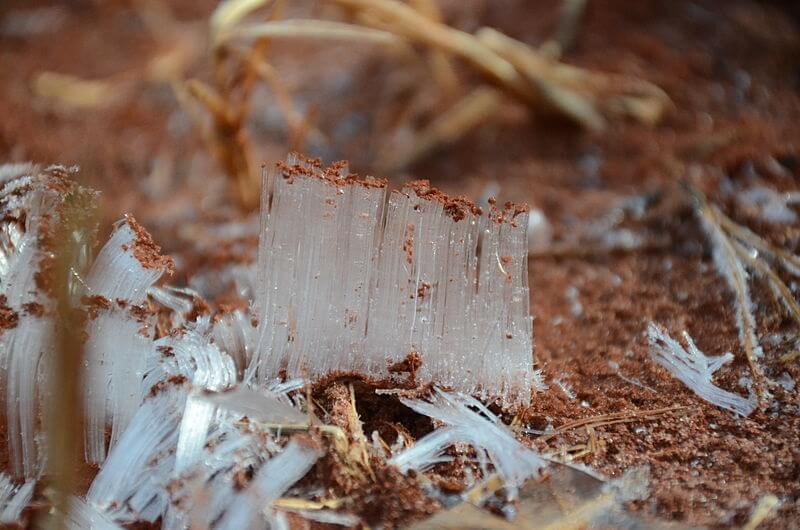Needle Ice: A Freeze-Frame Of Capillary Action
by Ser Anderson
Broadcast 1.2020 & 2.22 & 2.25.2023

Needle ice drawn up from the soil. Photo by Jared Stanley, CC 3.0.
Listen:
It was midnight and dark, but when my boots made crunching noises as I walked along the dirt road, I knew what was underfoot: tiny, clustered pillars of ice lifting the top layer of soil debris from the road. Now, in the light of the morning, the ice pillars look like miniature, partially buried, delicate ice castles. I am as intrigued by them now as I was when I first noticed them a few years ago, both here by Flathead Lake and up along McDonald Creek in Glacier National Park.
I wouldn’t have guessed that there was that much water in the soil and I don’t know why it freezes this way, in tiny columns rather than even tinier crystals distributed throughout the soil. It turns out that these small ice formations are called needle ice.
Needle ice is a form of ice segregation. Soil moisture is usually fairly evenly distributed throughout the soil, but when ice segregation occurs, that soil moisture migrates to certain points in the soil and freezes in clumps, “segregated” from the rest of the soil.
In the case of needle ice, the process of ice segregation requires a few specific conditions. There must be moisture in the soil. We didn’t get the anticipated storm yesterday, but it did spit icy rain in the morning before the day warmed up. The texture of the soil must be loose enough that there is space between the soil particles, but compact enough that the pore space is small enough for capillary action to occur, which is frequently related to high quantities of clay and silt in the soil. I’ve only ever found needle ice in the bare soil of trails or infrequently used dirt roads. The ground must be unfrozen when the air temperature drops below freezing. The last few days have been in the forties, before a wind coming down Flathead Lake from the north dropped the temperature below freezing yesterday afternoon.
I didn’t notice any ice when I was out a little after sunset last night, but by midnight, it had already formed enough to be loud beneath my hiking boots. Unseen by me, as night was falling and the air temperature continued to drop, moisture in the soil rose to the surface, drawn upwards against the downwards pull of gravity by the forces of cohesion and adhesion through narrow vertical channels in the soil in a process called capillary action. When the water arrived at the surface, or at the point slightly below the surface at which freezing was occurring, it froze, along what is known as the ice interface. As more moisture was drawn upwards over the course of the night, it began to hit the bottom of the ice and froze in turn, in the shape of the narrow “tube” through which it was drawn up through the soil. The water coming up from below pushed the already formed ice upwards out of the soil, often in clusters of long, thin “needles” of ice that crunched underfoot last night and fascinate me again when I can see them this morning.
Every week since 1991, Field Notes has inquired about Montana’s natural history. Field Notes are written by naturalists, students, and listeners about the puzzle-tree bark, eagle talons, woolly aphids, and giant puffballs of Western, Central and Southwestern Montana and aired weekly on Montana Public Radio.
Click here to read and listen to more Field Notes. Field Notes is available as a podcast! Subscribe on Apple Podcasts or wherever you listen to podcasts.
Interested in writing a Field Note? Contact Allison De Jong, Field Notes editor, at adejong [at] montananaturalist [dot] org or 406.327.0405.
Want to learn more about our programs as well as fun natural history facts and seasonal phenology? Sign up for our e-newsletter! You can also become a member and get discounts on our programs as well as free reciprocal admission to 300+ science centers in North America!












